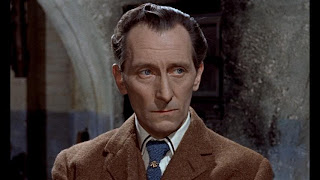The Legend of the Seven Golden Vampires (1973)
Peter Cushing, Julie Ege, David Chiang, and Robin Stewart
Director: Roy Ward Baker
Rating: Six of Ten Stars
The year is 1904. Decades have passed since Dr. Van Helsing first took up arms against the cult of vampires, and his struggle has brought him to China. While guest-lecturing at a university, Van Helsing is approached by His Ching (Chiang), who, together with his brothers and sister, have dedicated themselves to ridding his native village of the Seven Golden Vampires which have terrorized it for centuries; they require Van Helsing’s expertise in vampire-killing to augment their own considerable martial arts skills, however. Van Helsing and his son Leyland immediately offer their expert services. After wealthy Swedish adventuress Vanessa Buren provides funding, they embark upon the long and dangerous trek to the isolated village of Ping Kuei, facing both bandit lords and vampire minions before the final apocalyptic showdown between the vampiric army of the Seven Golden Vampires and Van Helsing’s band of heroes. Then, as the smoke is clearing, and heroes and villains alike are taking stock of their dead, Van Helsing’s arch-nemesis Dracula makes his presence known—and only one of them will walk away from this final confrontation.

When it was released, “The Legend of the Seven Golden Vampires” was something new and spectacular. It was the first serious effort to mix the horror film genre with the martial arts genre. With everything from “The Bride With White Hair” to “Blade” to “Vampire Effect” on our shelves, this movie may not seem like a big deal, but when Hammer and the Hong Kong-based Shaw Bros. production company teamed up, they were blazing new territory.
“The Legend of the Seven Golden Vampires” is a film with great potential and an even greater premise, but in the final analysis it fails to live up to both. While there are some great touches in the film surrounding Chinese vampire lore—the lesser vampire minions of the Seven Golden Vampires are “hopping vampires” and shrines to Buddha repulse the evil undead, not just the typical cross—and Cushing and the rest of the cast deliver fine acting performances, the martial arts side of the film is quite lackluster, even by the standards of Shaw Bros. movies of the 1970s. The big battle between the vampire army and the vampire-busting martial artists might have been more exciting if the martial arts displays had been. Certainly, that climactic battle had plenty of horror—with some quite unexpected twists and deaths as it unfolds—but its Kung Fu is weak.
On the upside, Cushing is a joy to watch as always (despite the fact that the actor was dealing with health issues and severe depression following the death of his wife), and his Van Helsing is again a fun mix of scholarly dedication and grim, determined action. He has great on-screen chemistry with everyone in the supporting cast—particularly Ege and Stewart. The addition of Leyland Van Helsing, the son of the great vampire hunter, is a nice addition to the mythos, and it’s too bad that nothing more came of that. (Hammer was always throwing in great characters in the Dracula films that never developed into anything—such as Father Sandor from “Dracula: Prince of Darkness.” But in the case of the younger Van Helsing, primed to take over the vampire-busting franchise, if the character was added simply because the film was deemed to need a vibe younger than the ailing Cushing, or if there were ideas of plans for a new Dracula/Van Helsing direction, “Legend” was destined to be among Hammer Films’ final productions.
Speaking of Dracula, readers have probably noticed that he’s only been mentioned in passing during this discussion. That’s because when Baker and the actors and the rest of the crew were all done with “The Legend of the Seven Golden Vampires,” Dracula was nowhere to be found in the story. In fact, it was Hammer executives who insisted that Dracula be added to the film, so Cushing was called back for an additional scene. An opening sequence featuring Dracula (played by John Forbes-Robinson) was hastily thrown together, along with a denouement that had Van Helsing dispatch Dracula without even being missed by his companions who stepped outside a moment before the Prince of Darkness revealed himself. I really can’t imagine what the people at Hammer were thinking; I think the pointless presence of Dracula in “The Legend of the Seven Golden Vampires” weakens the film rather than strengthens it.
By the way, I recommend you get the version of “The Legend of the Seven Golden Vampires” that Anchor Bay released as part of their Hammer Collection. Both the DVD and the VHS versions contain the US release of the movie that was titled “The Seven Brothers Meet Dracula.” The bit of film butchery is an example of how editing can make or break a film—and in the case of this movie, the editing definitely broke it. They took an entertaining, straightforward vampire/kung-fu hybrid adventure film and turned it into a confusing mess. When the Americans were done transforming “The Legend of the Seven Golden Vampires” into “The Seven Brothers Meet Dracula,” they had a movie that even Ed Wood and Uwe Boll would be ashamed to be associated with.
(Trivia: This was the fifth and final time Peter Cushing would play Van Helsing.)




